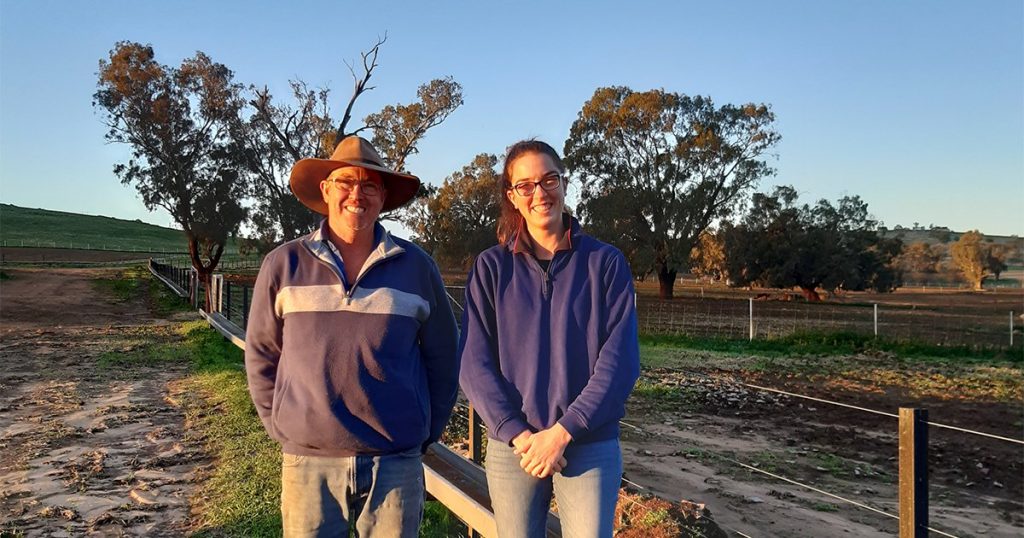
Derk and Fiona Meurs have used ewe containment to boost producivity.
EWE containment has served up big benefits for New South Wales prime lamb producers Derk and Fiona Meurs, including maintaining sheep condition, pasture conservation and reduced labour costs.
Derk manages the prime lamb‑focused property, ‘The Pinnacles’, at Wagga Wagga for Moulamein‑based Merino producers Ian and Camilla Shippen.
With two summers of joining up to 13,000 Merino ewes in containment behind him, Derk has told Meat & Livestock Australia he is confident his approach is maintaining the reproductive efficiency of his flock.
Along with his wife Fiona, daughters Sabrina, Nicole and Kristina and two casual staff members, Derk oversees 13,000 Merino ewes. Maiden ewes are joined to White Suffolk rams and mature ewes to Poll Dorsets.
But they have learned some valuable lessons, including avoiding using too many rams in containment yards, removing the tail end of ewes regularly to maintain flock welfare and health, and feeding early in the morning before it gets hot.
The operation began containment feeding in December 2018, following three years of below‑average rainfall and minimal ground cover.
“We decided containment feeding was the best option to save our country, reduce labour costs and maintain ewe condition,” Derk said.
Derk used 1.6–2ha pens and recommended a maximum of 700 ewes/pen. He has fed as many as 1500 ewes in a pen, but said large mobs can increase the occurrence of shy feeders.
Before constructing the lot, Derk attended an information day on drought lotting and spoke to other producers for their insights on constructing drought lots. Pen design was based around tree placement, so each pen had adequate shade.
He took slope into consideration and also incorporated a laneway for easy feeding and 4-metre concrete water troughs, which are cleaned every third day.
Last summer, ewes were shorn, vaccinated with 6‑in‑1 and drenched in September/early October, then fed in containment from early December 2019 to March 2020.
The induction ration was 200g/day/head of barley, trailed on the ground. This was steadily increased over two weeks. A small amount of bentonite was also added at the start of feeding, to manage acidosis. The full ration was 4kg/week/ head, increasing to around 6kg/week/head pre‑lambing.
Grain was fed six days a week, with cereal straw, salt and lime provided ad lib. A magnesium supplement (Causmag) and protein‑rich canola pellets were included as ewes approached lambing.
Derk fed ewes early in the morning when it was cool, as he suspected afternoon feeding may have contributed to increased acidosis.
“If you feed later in the day when it’s hot, they won’t come and eat until it cools down, at which point they gorge themselves,” he said.
Derk said he condition scored the ewes every two weeks. The tail was drafted out and fed in grazing paddocks. Last year, mature ewes in containment were joined on 1 December and maiden ewes were joined a month later.
Rams were used at one percent for both groups of ewes, with fresh rams swapped in every two weeks. Industry best practice is 2pc rams for maiden ewes; however, when Derk used this rate in 2018 he found there was too much fighting among the rams.
At scanning, mobs were separated and fed as singles and twins, and ewes were vaccinated again.
“We removed the ewes from the containment lot at least a month before lambing to minimise the risk of nutritional issues causing pregnancy toxaemia.
“This year the ewes from the drought lot recorded a slightly higher lambing percentage, ranging from 112–130pc, compared to ewes in the paddock at 110–125pc,” Derk said.
Source: MLA.

HAVE YOUR SAY